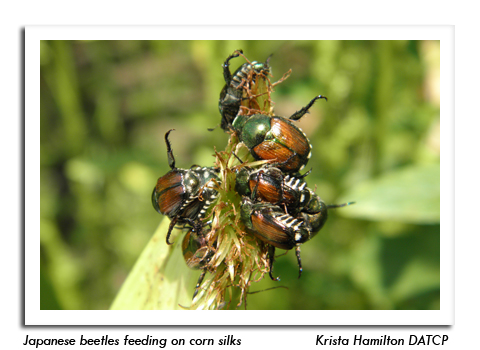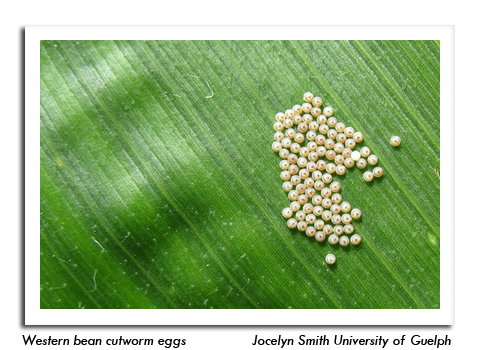
 |
|
|
Corn
Volume 64 Number 12 Date 07/18/2019 JAPANESE BEETLE - The annual emergence is well underway. Beetles are common at low levels in corn, soybeans, and fruit crops, and perimeter damage can be expected this month. For corn, the primary concern is to protect the silks from clipping since heavy beetle feeding on corn silks can impair pollination. Treatment may be justified for fields with three or more beetles per ear and silks that have been clipped to ½ inch when pollination is occurring (less than 50% complete). Japanese beetles collect on plants in the edge rows, emphasizing the importance of obtaining a representative sample from several areas throughout the field before making control decisions. Border row spot treatments may be sufficient if the beetles and damage are confined to the field edges. Beetles must be on the outside of the ear to be killed by contact insecticides. WESTERN BEAN CUTWORM - Emergence continued for the third week, with moths reported as far north as Durand in Pepin County. The DATCP network of 54 pheromone traps captured 51 moths, for a cumulative total of 55 moths since the flight began around July 1. Twenty-five percent adult emergence should occur over the southern half of the state next week. Oviposition on corn and dry beans is expected to increase as the moth flight escalates. In fields where egg masses and small larvae are found on 5% or more of the corn plants, an insecticide treatment applied at 90-95% tassel emergence will be most effective. This application timing increases the chance that the caterpillars will be exposed to the insecticide. Routine scouting should continue throughout the month. CORN ROOTWORM - Beetles are emerging in southern Wisconsin. Both the northern and western species were observed by DATCP survey specialists this week. A report indicates that lodging due to larval rootworm feeding has become apparent in VT corn in northern Lafayette County following storms on the night of July 16. EUROPEAN CORN BORER - DATCP is looking for cooperating corn growers to assist with its historic European corn borer fall abundance survey. To ensure that the survey results reflect the effects of non-Bt acres, for 2019 we would like to include at least one field of conventional corn from each county. Corn growers who will allow us to sample one of their conventional and Bt corn fields this fall are asked to email Krista Hamilton at krista.hamilton@wisconsin.gov. Please provide your name, phone number, and field location (GPS coordinates or other description of the field). Growers will be informed if their field has a high ECB population, but individual field locations and farmer information will not otherwise be shared. CORN EARWORM - Pheromone traps in Columbia, Dodge, Fond du Lac and Vernon counties registered counts of 1-12 migrants, and a weekly total of 22 moths in five traps. Three other monitoring sites reported zero moths this week. The economic threshold for this pest is 5-10 moths in three consecutive nights for corn, and seven per trap per week for tomatoes. Moth numbers from July 11-17 were as follows: Arlington 12, Beaver Dam 2, Coon Valley 3, Janesville 0, Marshfield 0, Pardeeville 2, Ripon 3, and Wausau 0. -- Krista Hamilton, DATCP Entomologist 





|
|
|